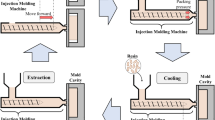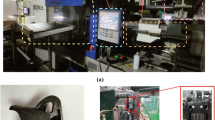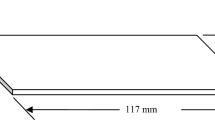Abstract
A stepwise optimization approach based on Gaussian process (GP) surrogate model is proposed to determine the process parameters and improve the quality control for injection molding. In order to improve the global performance in this optimization, an enhanced probability of improvement criterion is also introduced. Firstly, GP surrogate model is constructed with the initial samples which are obtained from an optimal design of experiment method. GP is capable of giving both a prediction and an estimate of the confidence for the prediction simultaneously. Secondly, an enhanced probability of improvement criterion is used to find the direction of adding training samples and optimize the surrogate model. Since the global optimal region of the model become accurate efficiently after steps of optimizing the surrogate model, the proposed enhanced probability of improvement criterion can switch more swiftly to global optima compared with other improvement criterion. Finally, an auto front grille molding process is taken as an example to illustrate the method. The results show that the proposed optimization method can effectively decrease the warpage of injection-molded parts.
Similar content being viewed by others
References
Huang MC, Tai CC (2001) The effective factors in the warpage problem of an injection-molded part with a thin shell feature. J Mater Process Technol 110:1–9
Erzurumlu T, Ozcelik B (2006) Minimization of warpage and sink index in injection-molded thermoplastic parts using Taguchi optimization method. Mater Des 27:853–861. doi:10.1016/j.matdes.2005.03.017
Fischer JM (2002) Handbook of molded part shrinkage and warpage. Plastics Design Library, USA
Jiang SL, Wang ZG, Zhou GF, Yang WM (2007) An implicit control-volume finite element method and its time step strategies for injection molding simulation. Comput Chem Eng 31(11):1407–1418
Choi DS, Im YT (1999) Prediction of shrinkage and warpage in consideration of residual stress in integrated simulation of injection molding. Compos Struct 47:655–665, PII:S0263-8223(00)00045-3
Chiang KT, Chang FP (2007) Analysis of shrinkage and warpage in an injection-molded part with a thin shell feature using the response surface methodology. Int J Adv Manuf Technol 35(5–6):468–479
Ozcelik B, Erzurumlu T (2005) Determination of effecting dimensional parameters on warpage of thin shell plastic parts using integrated response surface method and genetic algorithm. Int Commun Heat Mass 32:1085–1094. doi:10.1016/j.icheatmasstransfer.2004.10.032
Chen WC, Wang MW, Chen CT, Fu GL (2009) An integrated parameter optimization system for MISO plastic injection molding. Int J Adv Manuf Technol 44(5–6):501–511
Shen CY, Wang LX, Zheng QX (2005) Process optimization of injection molding by the combining ANN/HGA method. Polym Mater Sci Eng 21(5):23–27
Zhou J (2006) Single and multi-objective process optimization of injection molding using numerical simulation with surrogate modeling approaches and genetic algorithms. Dissertation, University of Winconsin-Madison
Seeger M, Williams CKI, Lawrence ND (2003) Fast forward selection to speed up sparse Gaussian process regression. In: Proceedings of the 9th International Workshop on Artificial Intelligence and Statistcs, Key West RFLP
Rasmussen CE, Williams CKI (2006) Gaussian Processes for Machine Learning the MIT Press, ISBN026218253X. Available at: www.GaussianProcess.org/gpml
Zhou J, Turng LS (2007) Adaptive multi-objective optimization of process conditions for injection molding using a Gaussian process approach. Adv Polym Tech 26(2):71–85. doi:10.1002/adv
Liao XP, Xia W, Long FY (2010) Gaussian process modeling of process optimization and parameter correlation for injection molding. J Mater Sci Eng 4(10):35
Forrester AIJ, Keane AJ (2009) Recent advances in surrogate-based optimization. Prog Aerosp Sci 45:50–79. doi:10.1016/j.paerosci.2008.11.001
Jones DR (2001) A taxonomy of global optimization methods based on response surfaces. J Glob Optim 21:345–383
Gao YH, Wang XC (2009) Surrogate-based process optimization for reducing warpage in injection molding. J Mater Process Technol 209:1302–1309. doi:10.1016/j.jmatprotec.2008.03.048
Gao YH, Wang XC (2008) An effective warpage optimization method in injection molding based on the Kriging model. Int J Adv Manuf Technol 37(9–10):953–960
Li C, Wang FL (2009) A modified global optimization method based on surrogate model and its application in packing profile optimization. Int J Adv Manuf Technol. doi:10.1007/s00170-009-2302-6
Sobester A, Leary SJ, Keane AJ (2005) On the design of optimization strategies based on global response surface approximation models. J Glob Opt 33:31–59
O’Hagan A (1978) Curve fitting and optimal design for prediction. J Roy Stat Soc B 40:1–42
Sciascio F, Amicarelli AN (2008) Biomass estimation in batch bio-technological processes by Bayesian Gaussian process regression. Comput Chem Eng 32:3264–3273. doi:10.1016/j.compchemeng.2008.05.015
Likar B, Kocijan J (2007) Predictive control of a gas-liquid separation plant based on a Gaussian process model. Comput Chem Eng 31:142–152. doi:10.1016/j.compchemeng.2006.05.011
Zhou P, Tian F, Chen X, Shang Z (2008) Modeling and prediction of binding affinities between the human amphiphysin SH3 domain and its peptide ligands using genetic algorithm-Gausian processes. Pept Sci 90:792–802. doi:10.1002/bip.21091
Yuan J, Wang K, Yu T, Fang M (2008) Reliable multi-objective optimization of high-speed WEDM process based on Gaussian process regression. Int J Mach Tool Manuf 48:47–60
Wu YS, Zhang K, Ding C, Pruess K, Elmroth E, Bodvarsson GS (2002) An efficient parallel-computing method for modeling nonisothermal multiphase flow and multicomponent transport in porous and fractured media. Adv Water Resour 25(3):243–261, PII:S0309-1708(02)00006-4
Sobester A, Leary SJ, Keane AJ (2004) A parallel updating scheme for approximating and optimizing high fidelity computer simulations. Struct Multidiscipl Optim 27:371–383. doi:10.1007/s00158-004-0397-9
Viana FAC, Venter G, Balabanov V (2010) An algorithm for fast optimal latin hypercube design of experiments. Int J Numer Methods Eng 82:135–156. doi:10.1002/nme.2750
Liao XP, Yan XL, Xia W, Luo B (2010) A fast optimal latin hypercube design for gaussian process regression modeling. In: 2010 Third International Workshop on Advanced Computational Intelligence (IWACI), Suzhou, China. pp 474–479
Gutmann HM (2001) A radial basis function method for global optimization. J Glob Opt 19:201–227
Author information
Authors and Affiliations
Corresponding author
Rights and permissions
About this article
Cite this article
Xia, W., Luo, B. & Liao, Xp. An enhanced optimization approach based on Gaussian process surrogate model for process control in injection molding. Int J Adv Manuf Technol 56, 929–942 (2011). https://doi.org/10.1007/s00170-011-3227-4
Received:
Accepted:
Published:
Issue Date:
DOI: https://doi.org/10.1007/s00170-011-3227-4




